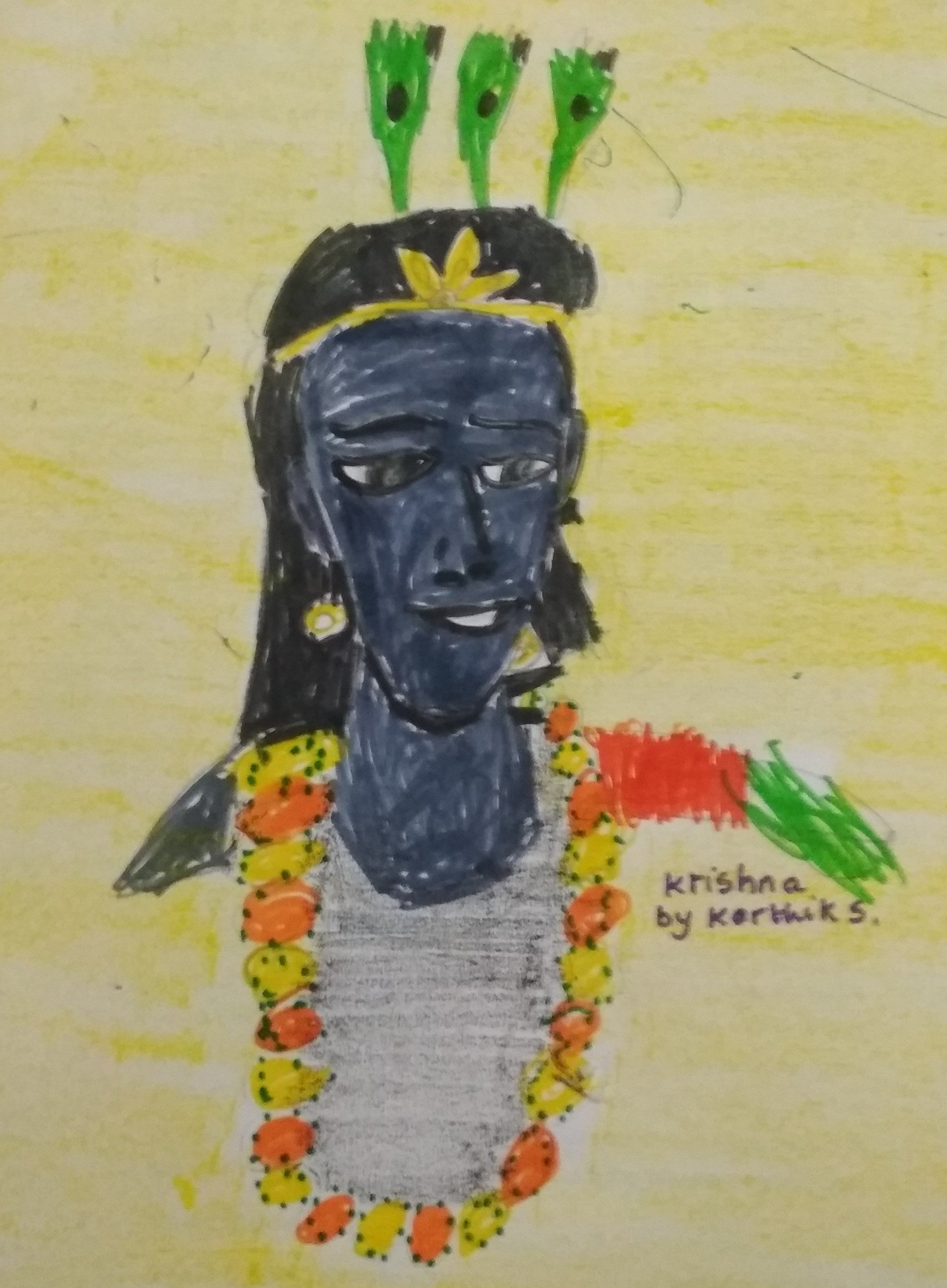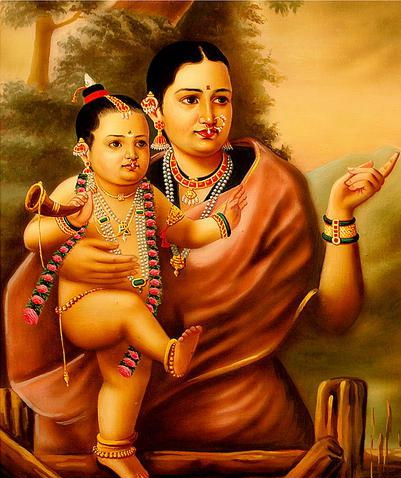Giving children a glimpse into Indian Art is an essential element of travelling around the country.
While Art can be fun and engaging at one level, at another level it is full of stories and symbols.
To explore one facet of this fascinating world, I have picked a question my children asked me when they were introduced to this popular image from Indian Art.
“Why is Krishna blue?”
Think about it – people (and gods) are shown as black, brown, wheatish, white – but blue?!
When one studies iconography – one gets to understand how certain symbols, icons and colours got associated with deities/ideas.

One of the primary sources is literature. For eg – the story of Shiva drinking poison that emerges from the Samudra Manthan is the reason he is the blue throated one – and shown blue in images.
But what about Krishna? Why is he blue in paintings and art? Surely, there must be a reason!
My quest to answer my childrens’ passing query led me to a chat with Tamil mythology expert Sumathi Sridhar, who also happens to be a big Amar Chitra Katha buff.

Sumathi sweetly agreed to do a guest post for India Travel Tales 4 Kids (the very first guest post here!) and discuss her research and findings about this curious question – that my kids and many others may have.
So…over to Sumathi…
Why is Krishna blue?
To this question, a child once answered that Krishna is blue because his friend doused him in blue ink with his pichkari. While we might laugh it off as childish imagination, in reality it’s not very far from the truth.
In fact, Krishna was not always blue. Several old sculptures of Krishna found in and around Mathura are carved in black stone. In sharp contrast, the image of Radha, his friend, is carved in white marble.

Clearly, for Krishna, the black stone was the sculptor’s choice.
Why did the sculptor choose black?
Maybe because Krishna was once a tribal god who was naturally dark complexioned. For example, the idol of Krishna at the Puri Jagannath temple in Orissa, which is believed to have tribal origins, is painted black even today.
Or maybe because the artist was drawing inspiration from the epic and puranic texts that compared Krishna’s skin tone to the dark monsoon clouds. For the artist, the god appeared dazzling in his megha-shyama varna, the colour of the dark monsoon clouds!

While Vedic literature do make a brief mention of Krishna, it is only in the Mahabharata that we find detailed references to the deity.
Coincidentally, in the same epic we find one more character who is dark-complexioned, Krishnaa alias Draupadi. Is it a mere coincidence that the epic’s author Vyasa
chose a dark complexion for two of the epic’s most powerful characters? Or is it because he was also Krishna (Vyasa was born Krishna Dwaipayana – the dark one born on an island) and he chose his own skin tone for his favourite characters? Well, two thousand odd years hence, we can only guess what his intentions might have been!
Some 1000 odd years after the Mahabharata, in Jain miniature paintings (of the 10-11th century) and in later period Pahari paintings and Mughal miniature paintings, we find Krishna painted blue in colour.
Why did Krishna suddenly turn blue?
Was it a change in the artist’s medium from stone to canvas? Or, was it something else?
The clue is possibly in the god’s name itself.
In Sanskrit, the word Krishna has multiple meanings. It means dark, black and, hold your breath, blue too!

So did the artist borrowing Krishna’s form and iconography from religious literature take the liberty of choosing blue over black from his palette? Maybe!
And, as Jinah Kim, Professor at Harvard, who has studied Colours and Pigments in Indian paintings, points out, colour experience is very subjective and varies from person to person.
That means that your blue is not my blue!
This is an interesting point to make children understand different perspectives.
Which is why Krishna is sometimes shown having an indigo blue skin tone (that is closer to black) and sometimes having a light-blue skin colour.
The Bhagawat Purana, that followed probably a millennium after the Mahabharata is a definitive text on the Krishna story that possibly influenced the Krishna iconography. A product of the Bhakti cult, the Purana puts Krishna at the centre of the Universe as an all powerful god.

He is an avatar of Vishnu, who is also blue in colour. Just as the blue waters sustain life, Vishnu sustains the Universe. And Krishna, as Vishnu’s incarnation, is likened to the vast and eternal skies and the oceans. These comparisons make blue the obvious choice of colour for Krishna. (You could introduce the concept of infinity and eternality to children.)
The deep blue sky Infinite and mystic,
Wonder what it hides in?
The answer I find
Ghanashyam I see,
Bhav, Bhakti Vishvarupa
Blue aura around me.Dr Manjiri Thakoor
Art Historian
Former Deputy Curator
NGMA (Mumbai)
So one finds that with the increasing popularity of the Krishna cult helped by the bhakti
compositions of Vaishnava saints such as Surdas and Jayadev, Krishna came to be the blue coloured god that we know today.
From black to indigo blue to sky blue, the god has been it all! The journey from taking the colour of a dark coloured cloud that dotted the skies to the colour of the endless blue sky itself has been a long one for the deity. (You can use this to introduce the concept of evolution of ideas to your child.)
All this time, the hues of Krishna changed and evolved to suit the taste and needs of his devotees!

After surfing the mythical world of business & finance for nearly 18 years, Sumathi Sridhar accidentally found herself washed ashore a fascinating world of mythology. A happy inhabitant of the new world ever since, she completed a course in Comparative Mythology from the Mumbai University. She writes regularly on Mythology for a Tamil magazine and also blogs (in English) at www.mytho-thoughts@blogspot.com

Shreyas Dhongade
September 8, 2018 - 5:41 am ·Mallika you are a bank of knowledge.
deysagnik
September 9, 2018 - 8:50 am ·i really like this interpretation of Krishna’s being indigo.I think you like exploring n excavating the indian tales which are hidden under the sands of time.I have started a blog on mythology n myth making.This is the link https://deysagnik.wordpress.com/2018/09/02/call-of-the-earth/ give it a try plz.I think you will like this story.It will hardly take 2 to 3 minutes.
Mallika Ravikumar
September 9, 2018 - 3:41 am ·Sure..will take a look. Thank you for your kind words. 🙂